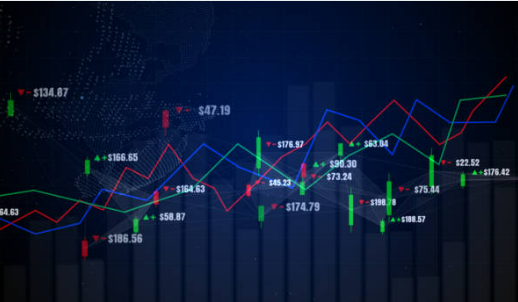
Haiden Holmes
Apr 19, 2022 17:07

The RSI is a widely used indicator in swing trading, a strategy in which traders ride out markets to make the best potential trades.
The RSI index reflects the relative strength of upward and downward movements but does not move in lockstep with the price.
When utilized appropriately, RSI displays high values during periods of market growth and low values during periods of market decline. The divergence between the RSI and the price indicates that the RSI indicator is going in the opposite direction of the price.
The relative strength index is a momentum indicator utilized in the technical analysis to assess whether a stock or other asset is overbought or oversold. The RSI is visually depicted as an oscillator (a line graph oscillating between two extremes) and ranges from 0 to 100. J. Welles Wilder Jr. invented the indicator, and then he published it in his important 1978 book, "New Concepts in Technical Trading Systems."
For most investors, RSI readings over 70 indicate an investment is overbought or overpriced and should be braced to see an abrupt change in trend or a correction in its price. A reading of 30 or less on the RSI indicator suggests an oversold or undervalued condition.
The RSI evaluates the difference between bullish and bearish price momentum and offers the findings in the form of an oscillator that may be displayed underneath a price chart. Since this is the case with most technical indicators, their signals are most reliable when aligned with a long-term trend.
Reversal signals are uncommon and might be difficult to distinguish from false alarms. For example, a false positive would be a bullish crossing followed by a sharp decrease in stock. A false negative would be a circumstance in which a bearish crossing occurs, but the stock accelerates higher unexpectedly.
Because the indicator measures momentum, it may remain excessively overbought or oversold for an extended period when an asset has considerable momentum in either direction. Thus, the RSI is most effective in an oscillating market when the asset price fluctuates between bullish and bearish swings.
The main trend of the stock or asset is critical for accurately interpreting the indicator's data. For instance, renowned market expert Constance Brown, CMT, has advocated for the notion that an oversold reading on RSI during an upswing is likely considerably higher over 30% and that an overbought reading on the RSI during a downtrend is likely much lower than the 70% level.
The RSI would peak at 50 percent, not 70 percent, throughout a downtrend, which investors may employ to more consistently signal adverse conditions. When a strong trend is in place, many traders will draw a horizontal trendline between 30 percent and 70 percent to assist them in recognizing extremes. Adjusting overbought or oversold levels is usually not essential when a stock or asset price is in a long-term horizontal channel.
A notion connected to employing overbought or oversold levels that correspond to the trend is to concentrate on trade signals and approaches that follow the trend. In other words, by using bullish signals when the price is in a bullish trend and negative signals when the stock is in a bearish trend, one may avoid the many false alarms generated by the RSI.
We will utilize it to make entry and exit choices in our swing trading strategy.
It is most often seen when the indicator moves in the opposite direction of the price.
Therefore, if the prices make a higher high and the indicator makes a lower high, this indicates a bearish divergence in the RSI.
Similarly, when prices make lower lows and the indicator makes higher lows, it indicates a bullish divergence in the RSI.
The most often used indicators for detecting divergences are as follows:
Stochastics
Moving Average Convergence and Divergence
Relative Strength Index (RSI)
Commodity Channel Index
William % R
Divergence occurs in technical analysis when the price of a security moves in the opposite direction to the direction predicted by another indicator or data set, in this instance, the Relative Strength Index.
Divergence may be either positive or negative: positive if it indicates that the price of an asset may rise, or negative if it indicates that the price will fall.
A positive divergence signal arises when a technical indicator climbs higher while the underlying security's price declines. Similarly, a negative divergence signal occurs when the indicator trends lower while the price increases.
As the relative strength index of a particular stock exhibits lower highs when the price uptrend reaches higher highs, this is referred to as RSI divergence. When the price is downward, it will lower lows with deviation, while the RSI will make higher lows. While both indicators are moving in the same direction, the RSI is deviating from the stock price.
Divergence implies that the present price trend is waning, indicating when it is appropriate to buy or sell a specific stock. When an indicator deviates from the price, this lack of synchronization signals a possible chart shift.
A concealed bullish divergence suggests that an uptrend is continuing. You'll observe that the RSI indicator creates a lower low than the price, which makes a higher low on the trend lines. On the other hand, a concealed bearish divergence occurs when a stock is heading lower. This trend is expected to persist when the RSI reaches a higher high than the price's lower high. Either of these gives the knowledge necessary to make an informed stock decision.
An RSI divergence indicator signal indicates this when the price movement and the RSI no longer exhibit the same momentum. The RSI indicator suggests the magnitude of a price movement over a specific time period. The RSI oscillator is one of the most often utilized oscillators in technical analysis, and divergence is calculated by comparing it to the current price action.
If a chart displays RSI divergence, the relative strength index (RSI) produces lower highs when the price makes a higher high or higher lows when the price makes new lower lows. When the RSI fails to break out to higher highs during an uptrend in price or fails to break down to lower lows during a trend in price, this is referred to as an RSI divergence.
A divergence between the RSI and the price movement indicates that the indicator does not agree with the price activity.
A bullish divergence occurs when the RSI indicator reaches an oversold level followed by a higher low that aligns with lower lows in the price action. This may indicate increased bullish momentum; a break above an oversold level is a frequently utilized buy signal for initiating a new long position.
A bearish divergence occurs when the RSI indicator reaches an overbought level followed by a lower high that aligns with the price action's higher highs. This may indicate a loss of momentum and a possible uptrend reversal. A break below an overbought level is a frequently utilized profit taking or short selling signal for initiating a new short position.
As is the case with the majority of technical indicators, the divergence between an asset's price action and the RSI Indicator is typically more dependable when it follows the pre-existing long-term trend and is measured over a longer time period.
For traders, this often means taking fewer bets in the market – but potentially higher gains if everything goes well.
Additionally, since the RSI Indicator is a measure of price momentum, it may display readings indicating an asset is overbought or oversold for extended periods. While this might be discouraging and seem to be a limiting characteristic, it also implies that divergence is an especially powerful signal when the market is swinging between bullish and bearish situations.
Finally, divergence is not a necessary or sufficient indicator of an impending price reversal, and market momentum might alter even without an accompanying divergence signal.
A divergence signal indicates that a significant price change is going to occur.
A common illustration of this is when a stock continues to make new lows while the RSI Indicator continues to make higher lows with each periodic swing in the asset's price.
A trader may deduce from this that the stock is losing downward momentum and that the present trend will revert to its previous orientation.
This would be a bullish divergence to the upside, signaling a trader to consider initiating a long position in the asset.
J. Welles Wilder invented the Relative Strength Index (RSI), a momentum (MOMO) indicator. The RSI was developed to measure the magnitude of a price movement while also providing signals of "overbought" or "oversold" scenarios.
The typical RSI setting is 14 periods, with 70 indicating overbought and 30 indicating oversold. A cross over 70 suggests that the ticker is about to enter a correction, pullback, or trend reversal phase, and across values, less than 30 indicate that the ticker is mispriced.
The 70 / 30 setup provides a trader with signals of price movement extremes. In a strong moving market, the RSI seldom goes below 40 and often oscillates between 50 and 80.
When the RSI reaches the 50 levels, it signals a trend shift. This is a more significant warning than a simple reading above or below the 70-30 lines since it provides an early warning.
When the indicator crosses over the 50 lines, it indicates that the average purchasing price for the period is more than the average selling price.
The converse is true if the 50 lines are crossed to the downside. These 50-line crossings might signal an excellent opportunity to initiate a trade during a pullback.
Divergence is best assessed over lengthy time periods; hence the larger the time span used to calculate divergence, the more accurate the findings.
The conventional time frame is 14 periods or 14 days when doing technical analysis using the Relative Strength Index. However, there are no hard and fast rules, and traders may use whatever interval length they are comfortable with.
Certain traders may want to raise or reduce this time period based on the asset class they are trading. For example, cryptocurrency traders may believe a shorter trading time is more acceptable given the security's proclivity for fast price moves, but traders in less volatile markets, where the underlying asset is less prone to significant price swings, may prefer 50 days.
Additionally, traders are not confined to utilizing the 30 and 70 levels when employing the RSI indicator.
For others, it's more sensible to employ the alternate 20 and 80 settings since this will inevitably boost the accuracy of any signal while decreasing its frequency. This, however, implies that some true momentum changes will be overlooked, depriving the trader of a chance to join a potentially successful trade.
When seeking more confirmation on the chart, price action analysis is usually an intelligent approach to use. You should employ every chart formation you notice to improve your trade's accuracy - trend lines, channels, chart patterns, and candle patterns.
This strategy aims to validate the occurrence of an RSI divergence by matching it to a price movement signal. Then, you should hold the trade for as long as price movement permits or until an opposing RSI signal appears.
Always utilize a stop-loss order to safeguard the balance of your account.

The 15-minute chart of the AUD/USD currency pair is shown above. At the bottom of the chart, we have the RSI indicator with its default parameters.
This scenario starts with a bullish trend, which we have shown on the chart with a blue trend line.
The orange lines on the chart indicate the price action's higher peaks and higher troughs. Additionally, the orange lines on the RSI indicator indicate a negative divergence, which the RSI indicates.
After identifying the RSI divergence, we see that the price tries a reversal and bearishly challenges the trend line. Suddenly, we witness a trend breakthrough, which is the price action signal we need to sell.
Who should place your stop-loss order above the peak generated at the time of the price reversal? We've indicated the halt with a red horizontal line in the photograph.
Now, we'll use price action principles to calculate the trade's exit point. The pink bearish line indicates the trend that the price will follow on its descent. Suddenly, a bullish candle breaks over this trend line, signaling the conclusion of the price decline. This seems to be an attractive exit position, and we complete the trade with a profit of 31 pips.
The RSI divergence indicator works well in conjunction with a variety of other technical analysis methodologies. Consider the following suggestions for incorporating this strong indicator into your current trading routine:
When used with RSI divergence analysis, the Bollinger band strategy provides information regarding prices above and below market value. Bollinger bands are a commonly used stock technique that gives information about when to buy, sell, or trade a stock. Locate a moving average line and add bands on each side equal to the standard deviation. This enables you to assess stock volatility and strategize your next move.
When used in combination with a candlestick strategy, the RSI may shed light on resistance and support zones and the price structure. Candlestick charts, primarily employed in day trading, show whether a particular stock is bearish or bullish throughout the specified period. Traders may use this strategy to precisely time their entrance and departure from the market to maximize profit.
Utilize a moving average cross strategy to generate crossover, support, and resistance signals and RSI divergence to validate trends. A shift in trend is detected by this strategy when the moving average's trend line passes over a predefined point.

When used with the RSI, moving average convergence/divergence (MACD) may help maximize earnings by identifying histogram crossings and daily support and resistance levels. As with RSI, this strategy considers patterns and momentum to forecast a stock's future move.
Divergence is a term that is not only associated with RSI. In general, divergence refers to something acting differently from another. In economics or financial analysis, divergence occurs when two measures or statistics that generally exhibit similar trends behave differently at the same time - for example, if the US GDP is increasing while the EU GDP is declining, we may say that the US and EU GDPs are diverging.
Divergence in technical analysis refers to the fact that we are receiving contradictory signals or information from two distinct indicators or (most often) from price and a technical indicator.
We can comprehend it by distinguishing between regular and concealed divergence.
Divergence regularly is a trend reversal signal, but divergence on a concealed basis is a trend continuance signal.
During a period of upward movement.
Once the price produces a higher Low, but the oscillator creates a lower Low, the situation is reversed.
The upward trend should continue.
During a bear market.
Once the price establishes a lower high, but the oscillator establishes a higher high
The trend should remain bearish.
The Relative Strength Index (RSI) Divergence Indicator (DI) is a critical component of every trader's toolkit. When combined with additional factors, like the actual trading price of a security, it may be a very useful tool for anticipating long-combination trend reversals.

Apr 19, 2022 16:42

Apr 19, 2022 17:58